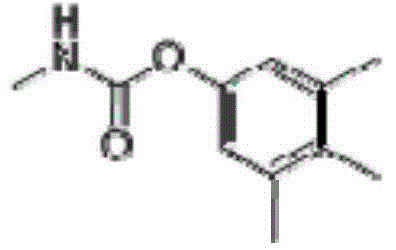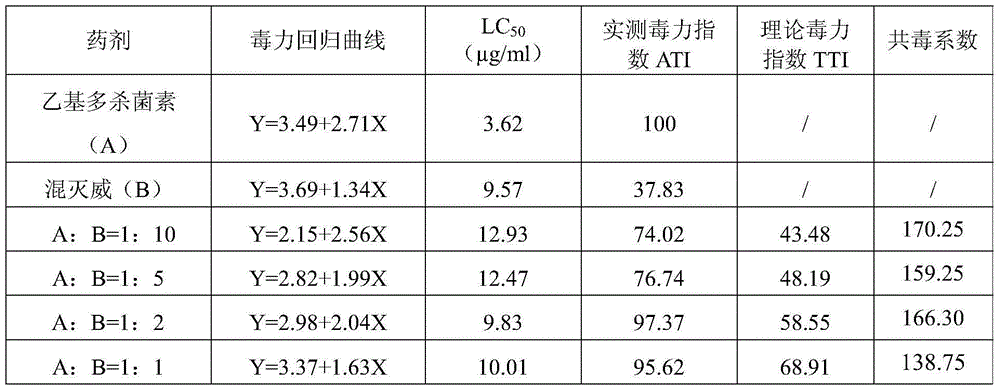Synergistic insecticidal composition containing spinetoram and mixed dimethylphenyl methylcarbamate, and applications thereof
A technology of spinosad and insecticidal composition, applied in the field of pesticides, which can solve the problems of high cost of pesticides for farmers, inability to protect crops, and easy occurrence of pesticide resistance, etc., to reduce the amount of pesticides used in the field, reduce environmental pollution and pesticide residues , Reduce the effect of prevention and control labor costs
- Summary
- Abstract
- Description
- Claims
- Application Information
AI Technical Summary
Problems solved by technology
Method used
Image
Examples
Embodiment 1
[0021] Weigh spinosyn and busidicarb and prepare spinosad and busicarb emulsifiable concentrate with a weight percentage of 30% of the main active ingredient by using conventional preparation methods in different proportions. See Table 1 for specific proportions.
[0022] Toxicity of spinosad, mixicarb and their compound samples to cotton bollworm was determined by feed poisoning method, each treatment was repeated 3 times, 30 heads were treated at each concentration, and LC was used. 50 Calculate the co-toxicity coefficient according to Sun Yunpei's method:
[0023] Table 1 Toxicity determination and co-toxicity coefficient of spinosad, mixicarb and their compound samples to cotton bollworm
[0024]
[0025] The data in the table shows that after the mixing of pleocidin and busicarb, there is a synergistic effect on cotton bollworm, and the co-toxicity coefficients of the four ratios listed in the table are all greater than 120, so pleocidin and mixed Dicarb mixing has a...
Embodiment 2
[0027] Weigh spinosyn and busidicarb and prepare spinosad and busicarb emulsifiable concentrate with a weight percentage of 30% of the main active ingredient by using conventional preparation methods in different proportions. See Table 2 for specific proportions.
[0028] The rice stem dipping method was used to determine the toxicity of spinosad, mixed-dicarb and their compound samples to rice brown planthopper, each treatment was repeated 3 times, and the LC 50 Calculate the co-toxicity coefficient according to Sun Yunpei's method:
[0029] Table 2 Toxicity determination and co-toxicity coefficient of spinosad, mixicarb and their compound samples against rice brown planthopper
[0030]
[0031] The data in the table shows that the mixture of spinetoram and busicarb has a synergistic effect on rice brown planthopper, and the co-toxicity coefficients of the four ratios listed in the table are all far greater than 120. Dicarb mixing has a significant synergistic effect.
Embodiment 3
[0033] Weigh 5g of spinosad, 20g of mixicarb, 4g of calcium dodecylbenzenesulfonate, 3g of phenethylphenol polyoxyethylene ether, and xylene to 100g, and mix the above raw materials according to the conventional method of preparing emulsifiable concentrate Mix in the kettle to form the spinetoram-bufencarb emulsifiable concentrate whose main active ingredient weight percent content is 25%.
[0034] Adopt the sample that embodiment 3 is equipped to carry out the field test of field control cotton bollworm in field, contrast agent is 60 grams per liter of spinosad SC and 50% mixed carbamide EC, and concrete consumption is shown in Table 3, and water consumption per mu is 30kg 3 days, 7 days, 14 days, and 28 days results were checked after the medicine. The test results are shown in Table 3:
PUM
 Login to View More
Login to View More Abstract
Description
Claims
Application Information
 Login to View More
Login to View More - R&D Engineer
- R&D Manager
- IP Professional
- Industry Leading Data Capabilities
- Powerful AI technology
- Patent DNA Extraction
Browse by: Latest US Patents, China's latest patents, Technical Efficacy Thesaurus, Application Domain, Technology Topic, Popular Technical Reports.
© 2024 PatSnap. All rights reserved.Legal|Privacy policy|Modern Slavery Act Transparency Statement|Sitemap|About US| Contact US: help@patsnap.com










